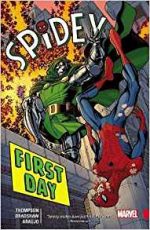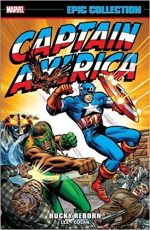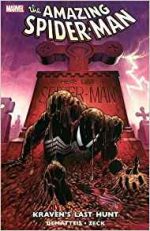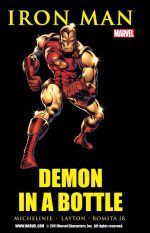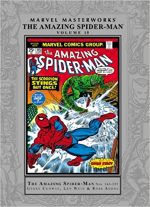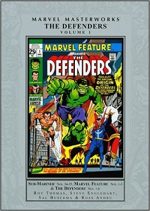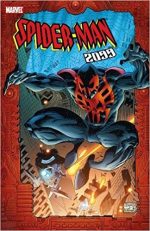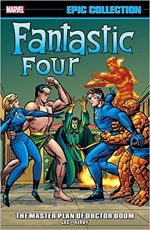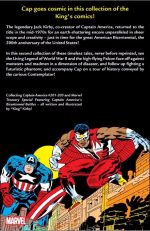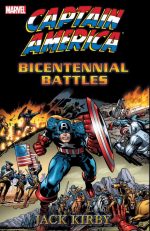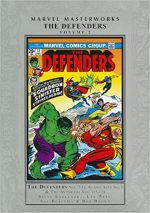
By Steve Englehart, Tony Isabella, Len Wein, Sal Buscema, Bob Brown, Jim Starlin & various (Marvel)
ISBN: 978-0-7851-4216-4
The Defenders were the last of the big star-name conglomerate super-groups, and would eventually number amongst their membership almost every hero – and some few villains – in the Marvel Universe. No real surprise there, since the initial line-up was composed of the company’s major league bad-boys: misunderstood and mad, outcast and bad and so often actually dangerous to know.
The genesis of the team derived from their status as publicly distrusted “villainsâ€, and they never achieved the “in-continuity†fame or acceptance of other teams, but that simply seemed to leave the creators open to taking a few more chances and playing the occasional narrative wild card.
This second sterling and sturdy hardcover (and eBook) masterworks collection assembles a veritable host of Fights ‘n’ Tights wonders from a large list of sources: Defenders #7-16, Giant Sized Defenders #1 and Avengers #115-118, encompassing cover-dates August 1973 to October 1974 and commences after author Steve Englehart shares recollections of his groundbreaking tenure in an informative Introduction, after which Defenders #7 jumps right in as Len Wein co-scripts with Englehart and Frank Bolle inks Sal Buscema in ‘War Below the Waves!’
Here tempestuous ex-Avenger Hawkeye temporarily climbs aboard the “non-team†bandwagon to help defeat the undersea threat of Attuma and soviet renegade the Red Ghost; a bombastic battle to usurp the Sub-Mariner of his titles and kingdom concluded a month later in ‘…If Atlantis Should Fall!’ with Englehart once more providing all the words and Frank McLaughlin inking…
Since Defenders #4 the forward-thinking scripter had been putting players in place for a hugely ambitious cross-over experiment: one that would turn the comics industry on its head, and next here comes a little prologue taken from the end of Avengers #115 which finally set the ball rolling.
Drawn by Bob Brown & Mike Esposito, ‘Alliance Most Foul!’ sees interdimensional despot the Dread Dormammu and Asgardian god of Evil Loki unite to search for an ultimate weapon to give them final victory against their foes. They resolve to trick the Defenders into securing the six component parts by “revealing†that the reconstructed Evil Eye could restore the petrified Black Knight.
That plan was initiated at the end of Defenders #8: a brief opening chapter in ‘The Avengers/Defenders Clash’ entitled ‘Deception!’ as a message from the spirit of the Black Knight is intercepted by the twin entities of evil, leading directly to ‘Betrayal!’ in Avengers #116 (by Englehart Brown & Esposito) wherein the World’s Mightiest Heroes – hunting for their missing comrade – “discover†their old enemies Hulk and Sub-Mariner may have turned the Black Knight to stone.
This and third chapter ‘Silver Surfer Vs. the Vision and the Scarlet Witch’ see the rival teams split up: one to gather the scattered sections of the Eye and the other to stop them at all costs…
Defenders #9 (with Buscema & McLaughlin art) begins with tense recap ‘Divide …and Conquer’ before ‘The Invincible Iron Man Vs. Hawkeye the Archer’ and ‘Dr. Strange Vs. the Black Panther and Mantis’ sheds more suspicion and doubt on the vile villains’ subtle master-plan…
Avengers #117 ‘Holocaust’, ‘Swordsman Vs. the Valkyrie’ and crucial turning point ‘Captain America Vs. Sub-Mariner’ (Brown & Esposito) lead to the penultimate clash in Defenders #10 (Buscema & Bolle) in ‘Breakthrough! The Incredible Hulk Vs. Thor’ and the inevitable joining together of the warring camps in ‘United We Stand!’, but tragically too late as Dormammu seizes the reconstructed Evil Eye and uses its power to merge his monstrous realm with Earth.
Avengers #118 delivers the cathartic climactic conclusion in ‘To the Death’ (Brown, Esposito & Giacoia) wherein all the heroes of the Marvel Universe resist the demonic invasion as Avengers and Defenders plunge deep into the Dark Dimension itself to end forever the threat of the evil gods (or for the moment, at least…).
With the overwhelming cosmic threat over the victorious Defenders attempt to use the Eye to cure their petrified comrade, only to discover that his spirit has found a new home in the 12th century. In #11’s ‘A Dark and Stormy Knight’ (Bolle inks), the group battle black magic during the Crusades, fail to retrieve the Knight and acrimoniously go their separate ways – as did overworked departing scripter Englehart…
With issue #12 Len Wein assumed the writer’s role, starting a run of slightly more traditional costumed capers as Sal Buscema & Jack Abel illustrated the return of the mind-bending Xemnu in ‘The Titan Strikes Back!’ against a pared-down cast consisting of Strange, Valkyrie and the Hulk.
A bona fide hit, the non-team were part of a big experiment in extra-value comics that began with opens with Giant Sized Defenders #1 (July1974): a stunning combination of highly readable reprints wrapped in a classy framing sequence by Tony Isabella, Jim Starlin & Al Milgrom. The vintage thrills commence with Stan Lee, Jack Kirby & Dick Ayers’ ‘Banished to Outer Space’ from The Incredible Hulk #3, followed by magnificent 1950s Bill Everett Sub-Mariner fantasy-feast ‘Bird of Prey!’
From there the focus switches to Dr. Strange and the Denny O’Neil/Steve Ditko mini-masterpiece ‘To Catch a Magician!’ (Strange Tales #145) before the concoction concludes with a blockbusting battle as the star trio, sorcerer’s apprentice Clea and the valiant Valkyrie dispatch a self-inflicted mystic menace.
After a splendid double-page pin-up by Sal Buscema the regular epics resume for a spectacular Saves-the-World struggle against the villainous Squadron Sinister that opens in ‘For Sale: One Planet… Slightly Used!’ (featuring an early inking job for Klaus Janson) and concludes in the Dan Green-embellished ‘And Who Shall Inherit the Earth?’ as Marvel’s Batman-analogue Nighthawk unites with the Defenders to defeat his murderous former team-mates and aquatic alien marauder Nebulon, the Celestial Man.
Defenders #15 initiates a two-part duel with manic mutant Magneto who first institutes a ‘Panic Beneath the Earth!’ – courtesy of Wein, Buscema & Janson – leading X-Men mentor Charles Xavier to enlist the outcast heroes’ aid. The concluding clash includes the insidious Brotherhood of Evil and ‘Alpha, the Ultimate Mutant’ (inked by Esposito) as well as the apparent end of true master of evil…
Also included here are behind-the-scenes treats including contemporary house ads, creator biographies and previous collection covers by Carlos Pacheco, John Romita and Richard Isanove.
For the longest time, The Defenders was the best and weirdest superhero comicbook in the business, and if you love superheroes but crave something just a little different these yarns are for you… and the best is still to come.
© 1973, 1974, 2011 Marvel Characters, Inc. All rights reserved.

